Azienda Agricola Casale (Certified Organic & Biodynamic)
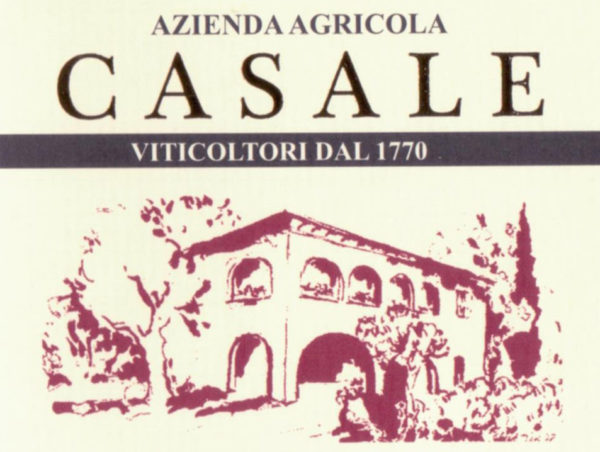
The Estate
Azienda Agricola Casale can trace its history to the end of the 18th century, according to historical texts. Today, it is managed by Antonio Giglioli, who has a degree in prevention techniques in medicine and surgery. He is a pioneer of biodynamics in Tuscany, having begun to explore the relationship between the energies of the cosmos and the dynamic balance of the plant in the early 1980s.
To convince his father to adopt a new approach, Antonio began to cultivate vines planted on a hill following Steiner principles in order to compare them with those vines managed by his father. By 1983, the aromas that were coming from the biodynamic vineyard were incredible, and the resulting wine was fine and complex. Since then, the entire property has been managed by enhancing the metabolism of the plant through the preparation 500, bioactivator of all its processes. The secret for Antonio lies in the biology of the soil and in the availability of high quality elements for the plants, in order to allow them to activate their defenses against diseases. Casale has been Demeter certified since 1995.
Antonio Giglioli is a great interpreter of Sangiovese and biodynamics, with its maximum expression reached in the Chianti DOCG Riserva, but also in its white Trebbiano (aged 10 years in chestnut barrels), its precious and memorable Vinsanto (from Trebbiano – it keeps kegs from the 1960s and some products from his grandfather even earlier), its vinegar, brandy, and even their olive oil.
Location: Situated in Certaldo, between Florence and Siena, in the Val d’Elsa. This is the town where Boccaccio seems to have been born, the cradle of art, history and beauty. But it is also the land of Chianti.
Production Area: 34 hectares, of which only 7 hectares are planted with vines.
Annual Production: 30,000 bottles
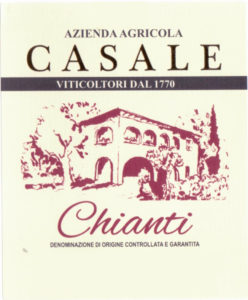
Chianti
Grape Varieties: 98% Sangiovese, 1% Canaiolo, 1% Colorino
Alcohol: 13.5%
Harvest: Manual
Vinification: Maceration for 20 to 30 days to transfer vitality to the wine. The vinifications take place spontaneously with the use of indigenous yeasts – no clarification or stabilization.
Aging: In stainless steel big barrel of 50 hl.
Bottles Produced: 15,000
Tasting Notes: Full-bodied, fresh, and drinkable, proving to have substance and longevity.
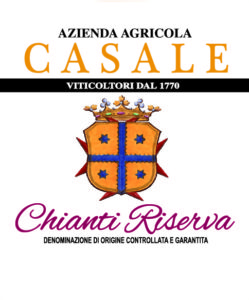
Chianti Riserva
Grape Varieties: 100% Sangiovese
Alcohol: 13.5%
Harvest: Manual
Vinification: Spontaneously fermented with indigenous yeasts and with maceration for 20 to 30 days.
Aging: In chesnut casks of 37 hl for 24 months
Bottles Produced: 13,000
Tasting Notes: A great Chianti Riserva from Antonio Giglioli. This wine is elegant, fine, and delicate, but still fresh and young. Fruity notes and an almost incredible complexity, this is the most surprising wine of the range.
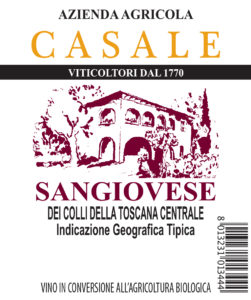
Sangiovese dei Colli della Toscana Centrale
Grape Varieties: 100% Sangiovese
Alcohol: 13.5%
Harvest: Manual
Vinification: Spontaneously fermented with indigenous yeasts and with maceration for 20 to 30 days.
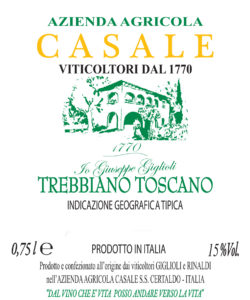
Trebbiano Toscano
Grape Varieties: 100% Trebbiano
Alcohol: 15%
Harvest: Manual
Vinification: Spontaneously fermented with indigenous yeasts and with maceration for 15 days.
Aging: In steel and in barrel
Bottles Produced: 2,200
Tasting Notes: Antonio Giglioli has accustomed us to timeless Chiantis – wines that are fresh and full of life even decades later. But the Casale property is also planted with white Trebbiano, a thick-skinned grape that loves to macerate as if it were a red. This wine is produced from a 55-year-old vineyard (Solatio) with yields of less than 50 q / li hectare. Dry and fragrant, with delicate hints of herbs, wildflowers, and yellow fruit.
Cantina Silbernagl (Organic)

The Estate
The 2.0-hectare Cantina Silbernagl, owned by Andrea Silbernagl, was established in 2012. It is situated in Brusata di Novazzano, a municipality in the canton of Ticino, Switzerland. Silbernagl is one of the lesser-known wineries in Ticino, but their wines are just as noteworthy. They produce monovarietal wines made from Chardonnay, Viognier, Sauvignon Blanc, Bondola, Merlot, and Cabernet Franc. There is also a production of verjuice, must, wine, and grappa from Bio Suisse certified Isabella grapes.
The family owns parcels in Sottoceneri that are planted mainly with Merlot. The plots are situated on the hills of glacial origin of the Mendrisiotto, with the Generoso mountain towering in the background. The wines from this area have a vibrant, mineral core with pure fruit expression.
In the cellar, Andrea has a “less is more” approach when it comes to vinifying his fresh, expressive wines. The steel barrels are 100, 150, 500, and 1,000 liters, while the wooden barrels are 228 liters barriques and the anfora are 250 liters. The wine is vinified by gravity. The distillation is carried out with a 150 liter bain-marie copper alembic. Only one-piece stoppers of natural cork are used.

Ticino Bianco Di Merlot
Appellation: Ticino DOC
Grape Variety: 100% Merlot. The grapes are grown in the village of Brusata, in the region of Mendrisiotto, Ticino, Switzerland.
Vinification: Traditional blanc de noir vinification in stainless steel tanks, only by gravity. Filtered before bottling.
Aging: Aged in stainless steel barrel.
Alcohol: 11.8%
Tasting Notes: Intense, straw yellow color. Floral with a note of citrus, and dry on the finish. Round and very elegant.
Storage: Store the bottles horizontally in a cool, dark place; the ideal temperature is a constant 16°C.

Ticino Merlot Botti di Acciaio
Appellation: Ticino DOC
Grape Variety: 100% Merlot. Coming from a very small production, this wine is the fruit of a single plot, grapes grown in the village of Brusata, in the region of Mendrisiotto, Ticino, Switzerland.
Vinification: Traditional vinification in stainless steel tanks, only by gravity.
Aging: Aged in stainless steel barrel. Filtered before bottling.
Alcohol: 13.0%
Storage: Store the bottles horizontally in a cool, dark place; the ideal temperature is a constant 16°C.
Tasting Notes: Intense garnet red color with a light garnet red reflection. Ripe, fruity notes in the bouquet. Notes of spice and juicy dark fruit and berries on the palate with a dry finish. This is a round and elegant Merlot.

Ticino Bondola
Appellation: Ticino DOC
Grape Variety: 100% Bondola (grape variety native to Ticino). Grapes grown in the village of Brusata, in the region of Mendrisiotto, Ticino, Switzerland.
Vinification: Traditional vinification in stainless steel tanks, only by gravity.
Aging: Aged in stainless steel barrel. Filtered before bottling.
Alcohol: 11.5%
Storage: Store the bottles horizontally in a cool, dark place; the ideal temperature is a constant 16°C.
Tasting Notes: Garnet color with an intense violet reflection. The Bondola is fresh with notes of ripe raspberry and a hint of spice. Dry finish. Rustic, and at the same time very elegant.
Food Pairings: Pairs well with bread, cheese, salami and pickles.
Cascina Morassino
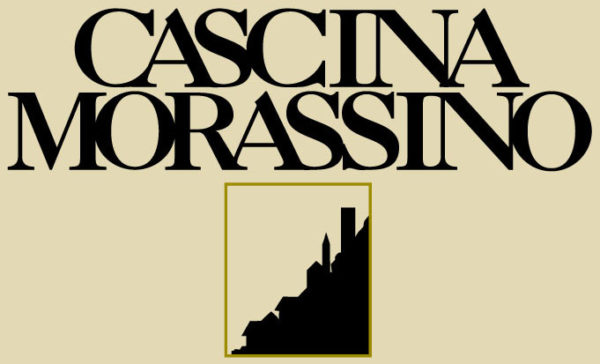
The Estate
Cascina Morassino was established in 1984 following the division of Azienda Agricola Bianco Luigi e Mauro, formerly Bianco Alfredo & Figli. It spans an area of 3.5 ha of vineyards in the village of Barbaresco, official cru Ovello, and 1 ha in the village of Neive. Roberto Bianco, the current owner, runs it with his family, which means he guarantees a personal, dedicated, and consistent approach both in the fields and in the cellars with the goal of creating unique, high quality wines. The vineyards, all facing southeast in Barbaresco and west in Neive at an altitude of 270 m above sea level, are planted with Nebbiolo (4 ha), Barbera (0.3 ha) and Merlot (0.2 ha). The soil is moderately clayey (limestone marl). The recently renovated cellar is equipped with temperature-controlled stainless steel vats: 35-40 hl used for fermentation and storage, 10-28 hl stainless steel vats for storage, and 25 hl oak barrels and barriques for the aging and maturation phases. Annual production is approximately 20,000 bottles.

Barbaresco Morassino
Type of Wine: Barbaresco DOCG
Location: Southeast facing vineyards in the village of Barbaresco
Annual Production: 7,400 bottles
Grape Variety: 100% Nebbiolo
Aging: 18 months in 25 hl oak casks
Tasting Notes: Ruby red color with orange hues and full, round aromas. It is austere on the palate, but the tannins released by the grapes from older vines makes it mellow, soft, and long-lasting on the finish.
Serving Suggestion: Ready to drink a few months after it is bottled. Best paired with meat and game dishes, as well as aged cheeses.
Alcohol: 14.5%

Barbaresco Ovello
Type of Wine: Barbaresco DOCG
Location: Southeast facing vineyards in the village of Barbaresco. The grapes used for the Barbaresco Ovello are harvested from the best vineyard with optimal soil composition. A further selection is then made within that vineyard by locating the portions with the ripest and healthiest grapes.
Annual Production: 3,500 bottles
Grape Variety: 100% Nebbiolo
Aging: 22 months in 25 hl oak casks; first 12 months in new wood.
Tasting Notes: Structured, spicy, and complex.
Serving Suggestion: Ready to drink a few months after it is bottled. Best paired with meat and game dishes, as well as aged cheeses.
Alcohol: 15%
Langhe Nebbiolo
 Type of Wine: Nebbiolo
Type of Wine: Nebbiolo
Location:A west facing vineyard of 0,9 ha planted in 1970 in the village of Neive.
Annual Production: 4,000 bottles
Grape Variety: 100% Nebbiolo
Aging: The fermentation takes place in temperature controlled stainless steel and spends a further 6 months in oak vats.
Tasting Notes: The taste is full, pleasantly tannic and very persistent; fruity notes with hints of vanilla.
Serving Suggestion: It marries well meat based first courses and game as well as cheese.
Alcohol: 13.5%
Barbera d'Alba
 Type of Wine: Barbera d’Alba
Type of Wine: Barbera d’Alba
Location: A west facing vineyard of 0,3 ha in the Village of Neive.
Annual Production: 2,000 bottles
Grape Variety: 100% Barbera
Aging: Fermentation and maturation take place in stainless steel, followed by a further refinement of 6 months in bottle
Tasting Notes: Fresh fruit
Serving Suggestion: Best matched with cured meat, stews and full fat cheese.
Alcohol: 13.5%
Cécile Paquet (Certified Organic)
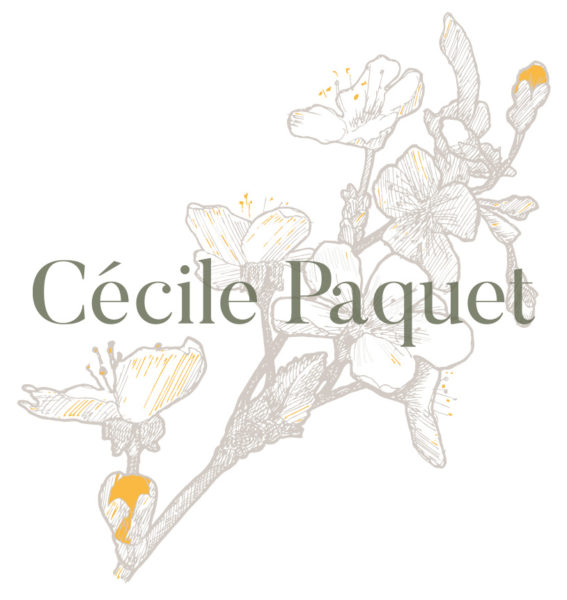
The Estate
Cécile Paquet grew up in a small village in southern Burgundy called Senozan. After more than 20 years working in plant nurseries, she decided to focus all her knowledge and expertise on the grapevine. Cécile works tirelessly in her micro domaine of 1.5 hectares to achieve the maximum expression of the terroir and craft wines of great quality. She works with the greatest of care, showing respect for the principles and rhythms of nature and the soil. The domaine is certified organic by Ecocert and practicing biodynamic.

Bourgogne Pinot Noir
Soil: Clay-limestone, muddy clay.
Grape Variety: 100% Pinot Noir
Viticulture: Certified organic and practicing biodynamic.
Vinification: The grapes are exclusively hand-picked into 15kg baskets and subjected to rigorous selection right in the vineyard and in the cellar. After this comes 9 days of maceration. The wine is neither fined nor filtered.
Aging: 14 months only in barrels.
Tasting Notes: Lovely ruby hue. Rich nose with aromas of red fruits (cherry, raspberry). Round on the palate with notes of licorice. Very complex, well-balanced and elegant Pinot Noir, typical from Burgundy.
Food Pairings: Can be appreciated as an aperitif, but also goes well with grilled red meats, chicken, creamy risotto, and cheeses.
Serving Temperature: 12-14°C

Mâcon-Villages
Location: The vines are planted in the commune of Igé in the Mâconnais region, in the southern part of Burgundy.
Soil: Clay-limestone, muddy clay
Exposure: Southeast
Grape Variety: 100% Chardonnay
Plant Density: 8,000 vines/ha
First Planting: 1987
Viticulture: Certified organic and practicing biodynamic
Vinification: Fermentation in temperature-controlled vats (cold) for 4 to 6 weeks. Use of natural yeast to allow the grape and the terroir to express themselves.
Aging: 100% in vats for 6 to 7 months to preserve the freshness of the Chardonnay. 100% malolactic.
Tasting Notes: This Mâcon-Villages has a pretty pale gold hue. Very perfumed nose of spring flowers and orchard fruits (pear, vineyard peach). The palate is rich, powerful, and well-structured. An easy-drinking wine.
Food Pairings: Ideal as an aperitif, but also delicious served with sushi, dim-sum, risotto, poultry, or with goat cheese.
Serving Temperature: 10-12°C

Saint-Véran
Location: Villages of Davayé and Prissé
Climate: Moderate
Soil: Clay-limestone, predominantly limestone
Exposure: South/southeast, north
Pruning Method: Guyot with short canopy
Grape Variety: 100% Chardonnay
Harvest: Manual harvest
Vinification: 100% malolactic fermentation.
Aging: 14 months in concrete tank.
Tasting Notes: This wine is suave and silky, offering aromas of citrus, pineapple and fresh almonds. The lively attack gives way to an ample wine with a long finish. Intense freshness with creamy texture.
Food Pairings: This Saint-Véran is a perfect accompaniment to scallops, seafood and fresh pasta, or can be enjoyed on its own, as an aperitif.
Serving Temperature: 12-13°C
Alcohol: 14%
Champagne de Sousa (Certified Organic & Biodynamic)
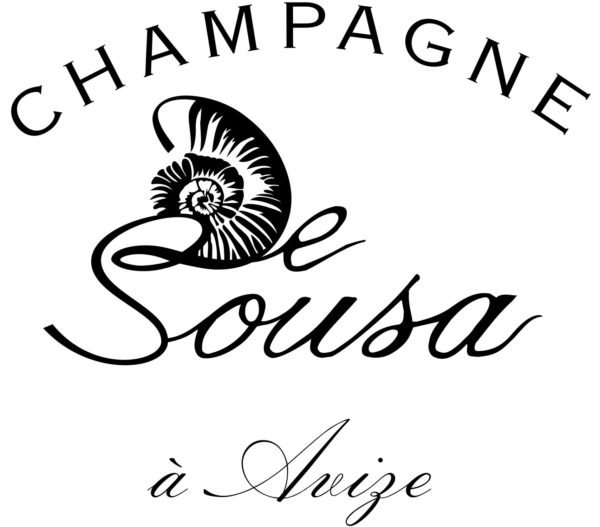
The Estate
Located in the heart of the prestigious Côte des Blancs, Champagne de Sousa has been in existence for 3 generations. Spanning 11 hectares, the vines are planted in the renowned Grands Crus of Avize, Cramant, and Oger. Winemaker Erick de Sousa and his family are devoted to authenticity and quality, and their cultivation of older vines (50+ years), use of organic fertilizer, and respect for the terroir have produced exceptional wines at bargain prices since 1986. Certified organic since 2010 and certified Demeter biodynamic since 2013.
The Terroir
- AOC: Champagne
- Production: 70-75,000 bottles De Sousa and 30,000 Zoémie De Sousa
- Founded: Prior to 1890
- Acreage: 11 Ha
- Layout: 42 different lots
- Geology: 100% Chalk
Cultivation
Domaine de Sousa is committed to using older vines to produce excellent champagnes. For its cuvees prestiges, grapes are only selected from vines that are more than 50 years old, with very small yields (25-30% less than the appellation, for 8,000 vines per ha). For its other vintages, an average of 70% of vines 25 years or older are used. These vines produce small yields, but result in a strong expression of the soil, and good maturity of grapes.
These older vines have roots called “pivots” which descend up to 10 or 12 meters to extract salts and trace elements from the chalky soil. The deeper the root is, the farther away it is from fertilizers, and the more it extracts nutritive elements from the soil, which guarantees high quality grapes.
- Fertilizers: Organic fertilizers authorized by EC regulations
- Pruning: Chablis – Cordon de Royat
- Grapes: 30% Pinot Noir, 10% Pinot Meunier, 60% Chardonnay (70% old vines)
- Average Age of Vines: Over 45 years of age
- Grafting: 41 B
- Yield per ha: according to the appellation, about 60 hectoliters per ha
- Plantation density: 8,000 vines/ha
- Plantation of New Vines: Only when necessary to replace older vines
- Antibotrytis Treatment: None
- Insecticide Spraying: Limited; only when necessary
The Wine-Making Process
Erick De Sousa, a subtle wine-maker, regulates the temperature at 18°C, in order to preserve the aroma of his wines. The 5.5 ha vineyard is harvested completely by hand, as late as possible, so as to pick the ripest grapes with the strongest fragrances.
When making his wine, he uses traditional methods taught to him by his father (a wine producer from a long line of them) who opted for malolactic fermentation to soften his wines. He also applies the old technique of a -4°C cold period with the aim of obtaining the clearest possible Champagne. Erick also applies his family know-how to the blending of the old wines to balance his wines and get consistent quality.
- Origin of yeast: Technical Oenological Center
- Fermentation time: 15 to 20 days
- Chaptalization: When necessary to obtain 11% alcohol
- Temperature Regulation: Immersed cooling coil
- Fermentation Temperature: 18°C
- Vats: Coated steel end barrels
- Cuvee Wine: 75% in 1992, 100% since then
- Filtration: Lightest possible
- Wine-maker: Erick De Sousa
- Oenological Advisor: James Darsonvilles
Fermentation
Vinification in coated steel vats preserves the authenticity of the soil. Domaine de Sousa managed to have one year of stock for the blendings. Since 1995, vinification is done in small oak barrels to give matter to the wine.
Maturation
In the chalk cellar, the temperature is maintained at a consistent temperature of 10°C. The wine matures slowly in the darkness and perfect quietude.
2.5 years of production are kept in cellar as a buffer stock. The remuage is carried out manually.

Champagne Brut Tradition NV
Grape Varieties: 50% Chardonnay, 40% Pinot Noir, 10% Pinot Meunier
Location: Vallee de la Marne, Cote des Blancs, region d’Epernay
Soil: Clay and chalk
Average Age of the Vines: 25-30 years old
Viticulture: Organic and biodynamic. Horse plowing.
Harvest: 100% manual
Vinification: 100% in tank. No filtration/collage.
Cellaring: 3-5 years
Serving Temperature: 8-10°C
Tasting Notes: This majority Chardonnay Champagne is lively and refreshing, with notes of white flowers, citrus fruits, ripe pears, and red berries.
Food Pairing: Seafood, cheese, poultry, salty crackers.

Brut Rosé NV
Grape Varieties: 92% Chardonnay de Grauves 1er Cru, and 8% Pinot Noir d’Ay Grand Cru
Soil: 100% Chalk
Average Age of the Vines: 25-30 years old
Viticulture: Organic and biodynamic. Horse plowing.
Harvest: 100% Manually done
Vinification: 100% in tank, no filtration or fining.
Cellaring: 3-5 years
Serving Temperature: 8-10°c
Food Pairings: Salted crackers, desserts with red fruit
Tasting Notes: Fresh, full, and fruity. The Chardonnay lends aromas of white flowers and a slight minerality, while the Pinot Noir gives notes of ripened berries.

Champagne Grand Cru Brut Réserve Blanc de Blancs
Grape Varieties: 100% Chardonnay
Terroir: Cramant, Avize, Oger, Mesnil sur Oger and Chouilly Grand Cru
Soil: 100% Chalk
Average Age of the Vines: 43 years old
Viticulture: Organic and biodynamic. Horse plowing.
Harvest: 100% Manually done
Vinification:100% in tank. No filtration or fining
Cellaring: 3-5 years
Serving Temperature: 8-10°c
Food Pairings: Seafood, cheeses, salted crackers
Tasting Notes: This Champagne will delight you with its freshness, its elegant finesse, and its pure minerality. Buttery notes of brioche, along with ripe citrus on the palate.

Champagne Grand Cru Cuvée 3A
Grape Varieties:
50% Chardonnay d’Avize–Located at the heart of the Côte des Blancs, Avize is a village classified as Grand Cru Chardonnay with soils comprised of the purest chalk in all of Champagne. It is also home to belemnite fossils, which date back millions of years and lend freshness, minerality, and finesse to this wine. This cuvée is made up of a selection of grapes harvested from 50-year-old vines, which are then carefully vinified in 225-liter oak barrels.
25% Pinot Noir d’Aÿ–A village classified as Grand Cru Pinot Noir, Aÿ is located where the Marne Valley meets the Mountain of Reims. The slopes’ unique, full southern exposure and irregular topography allow the Pinot Noir grape to express its aromas of ripe fruit with power and finesse. These vineyards are planted with ancient varietials of Pinot Noir that produce small fruit with unique aromas. This historic village boasts sedimentary and limestone soils in which there is a high proportion of chalk.
25% Pinot Noir d’Ambonnay–Ambonnay, a village classified as a Grand Cru Pinot Noir, is located on the Mountain of Reims-a vast, forest covered plateau where the grape vines are planted in chalky soils. The forest plays the role of balancing the cold evening air that descends onto the plateau with the warm air produced during the day that rises toward the summit. The vines used were originally planted in the 1950s; they have low yields, but the grapes show greater maturity and more concentration. Unlike Chardonnay, a fragile, delicate varietal, Pinot Noir is vigorous and is well-adapted to limestone soils to yield wines that stand out for their power and consistency. The aromas are very elegant, boasting red berry notes.
Name: Avize, Aÿ, and Ambonnay are the only three villages in Champagne classified as Grand Cru whose name begins with an “A”. This explains how this cuvée got its name, but what makes it unique is its composition of 50% Chardonnay from Avize blended with 50% Pinot Noir from Aÿ and Ambonnay.
Terroir: Cote des Blanc and Montagne de Reims
Soil: 100% Chalk
Average Age of the Vines: 25-30 years
Viticulture: Organic and biodynamic. Horse plowing.
Harvest: 100% manually done
Vinification: 50% in tank and 50% in oak barrel. No filtration or fining.
Cellaring: 3-8 years
Serving Temperature: 8-10°c
Food Pairing: Seafood, cheeses, poultry
Tasting Notes: The Cuvée 3A weds the finesse of the Chardonnay to the fullness of the Pinot Noir. Notes of lemon and pineapple on the nose, and buttery hints from the partial oak aging. There are also notes of blackcurrant and raspberry.

Champagne Grand Cru Cuvée des Caudalies
Grape Varieties: 100% Chardonnay
Terroir: Côte des Blancs en Grand cru
Soil: 100% chalk
Average Age of Vines: More than 60 years
Viticulture: Organic and biodynamic. Horse plowing.
Harvest: 100% manually done
Vinification: 100% oak barrels. No filtration or collage.
Cellaring: 8-15 years
Serving Temperature: 8-10°C
Food Pairings: Seafood, aged cheeses.
Tasting Notes: Pale gold in color. The nose is elegant, delicately punctuated by woodsy aromas. This polished Champagne offers creamy texture and harmonious structure. The oak notes are present but well integrated.

Cuvée des Caudalies, Avize, Les Pierres Vaudons
Location: Avize, Grand Cru in the Côte des Blancs. Located to the south/southeast of Épernay.
Lieu Dit: Les Pierres Vaudons is a plot situated on the southern edge of Grand Cru Avize, just above Grand Cru Oger.
Grape Variety: 100% Chardonnay
Average Age of the Vines: 50+ years old
Viticulture: Organic and biodynamic. Horse plowing.
Vinification: A selection of the best juices from the pressing of old vines. 10 months of vinification in oak barrels. Use of indigenous yeasts and no filtration. Batonnages in barrels and 2 poignettages (shaking/moving of the bottles) in the cellar. Stabilization in the cellar after 12 months of disgorgement.
Aging: 7 years maturation in cellar
Cellaring: 15-20 years
Winemaker Tasting Notes: “Pale gold color. At the start, a rich expression of dried fruits, biscuits, and almond cookies. Beyond that, more root elements are defined: green anise, fennel, wet stone, and copper. After breathing for a bit, syrupy and liqueur-like essences (limoncello, acacia syrup) are revealed, with hints of mushroom, cigar, and blond tobacco. On the palate, there is a fatty richness and almost nuttiness. Notes of blond caramel, dried leaves, and earthy mushrooms.”

Cuvée des Caudalies, Le Mesnil, Les Chetillons
Location: Le Mesnil-sur-Oger, Grand Cru in the Côte des Blancs. Located to the south/southeast of Épernay.
Lieu Dit: Les Chetillons is a small plot situated on a hillside in Le Mesnil-sur-Oger facing east/northeast.
Grape Variety: 100% Chardonnay
Average Age of the Vines: 50+ years old
Viticulture: Organic and biodynamic. Horse plowing.
Vinification: A selection of the best juices from the pressing of old vines. 10 months of vinification in oak barrels. Use of indigenous yeasts and no filtration. Batonnages in barrels and 2 poignettages (shaking/moving of the bottles) in the cellar. Stabilization in the cellar after 12 months of disgorgement.
Aging: 7 years maturation in cellar
Cellaring: 15-20 years
Winemaker Tasting Notes: “Golden yellow color. The first aromas are immediate and precise: carbon and pencil lead. This is followed by fresh cut white flowers, spring humus, sweet spices, iodine, lemony salt, apricot, mirabelle plum, and butter cookie. The finish is slightly smoky, with hints of pure gray salt and the sweet fragrances of white truffles and cashew nuts. Tenderness, richness, and smoothness contrast the palate with a tense tangy flavor, sharpened by green citrus, and yellow and green apples.”

Champagne Grand Cru Brut Cuvée des Caudalies Rosé
Grape Varieties: 90% Chardonnay d’Avize and 10% Pinot d Noir d’Aÿ
Terroir: Côte des Blancs and Montagne de Reims Grand Crus
Soil: 100% Chalk
Average Age of the Vines: More than 60 years old
Viticulture: Organic and biodynamic. Horse plowing.
Harvest: 100% manually done
Aging: 100% oak barrels. No filtration or collage.
Cellaring: 8-15 years
Serving Temperature: 8-10°C
Food Pairings: Oysters, veal, poultry, fruit-based desserts
Tasting Notes: Cuvée des Caudalies Rosé will delight you with its finesse and subtle aromas of fresh raspberries and kirsch cherry, as well as its buttered and toasted notes brought by its aging in oak barrels.

Champagne Grand Cru Mycorhize Blanc de Blancs Extra Brut
Overview: The use of horse and plow among the vines minimizes soil compaction, thereby contributing to the development of mycorrhizae. Mycorrhizae, or “mycorhize“, is the name for a symbiotic relationship between a fungus and plant. The fungus grows on the roots of the vine, which gives the vine increased water and nutrient absorption capabilities. In turn, the fungus benefit from the carbohydrates formed from photosynthesis of the vine.
Grape Varieties: 100% Chardonnay
Terroir: Les Hauts Nemery Grand Cru d’Avize
Soil: 100% chalk
Average Age of Vines: More than 60 years old
Viticulture: Organic and biodynamic. Horse plowing.
Harvest: 100% manually done
Vinification: 100% oak barrels. No filtration or collage.
Cellaring: 8-15 years
Serving Temperature: 8-10°c
Food Pairings: Seafood, poultry, aged cheeses, sushi
Tasting Notes: This is an elegant Champagne; the minerality and aromas of nuts, acacia, linden, honey, and a subtle hint of raspberry. It has vibrant energy that reflects the terroir of Avize.

Champagne Grand Cru Cuvée Umami
Overview: This Cuvée from De Sousa is inspired by but also completely embodies the term “umami”, which originates in Japan. Umami is the 5th basic flavor, along with sweetness, saltiness, sourness, and bitterness, and is hard to define exactly, but is best described as being a delicious, savory taste. This champagne can be described as such as it is characterized by its rich, velvety texture, depth of flavor, elegant minerality, and sapidity.
The Vines: The biodynamic techniques employed by the winemakers contribute greatly to the resulting flavor of the wine by increasing the life of the soil, facilitating the development of mycorrhizae which aid the vines in water retention and nutrient absorption, producing grapes that are richer in sugar, maturing acids, and harvesting grapes that have reached their full physiological maturity. The vines used for this Cuvée are more than 50 years old with low yields.
Viticulture: Organic and biodynamic. Horse plowing.
Vinification: The vinification process incorporates indigenous yeasts, after which the wine is matured in 225L oak barrels, with stirring of the fine lees.
Grape Varietals: 60% Chardonnay, 40% Pinot Noir
Soil: Chalk
Tasting Notes: The Umami has an intense and captivating bouquet, with caramel and toasted bread aromas. The Chardonnay grapes contribute elegant notes of apple and pear, while the Pinot Noir grapes lend black currant and raspberry savors. This champagne leaves a soft, long-lasting sensation on the palate, and has a delicate salinity which awakens the taste buds and causes slight salivation in the mouth. The density and vibrant minerality of this wine is imparted by the quality of sugars, glycerol, ripe acids, and alcohol.

Champagne Chemins des Terroirs Brut
Grape Varieties: 40% Chardonnay, 40% Pinot Meunier, 20% Pinot Noir
Terroir: Vallée de la Marne, Coteaux du Vitryat, and région d’Epernay
Soil: Clay and chalk
Average Age of Vines: 15-40 years
Viticulture: Organic and biodynamic. Horse plowing.
Harvest: 100% manual
Vinification: 100% tank
Cellaring: 3-5 years
Serving Temperature: 8-10°c
Food Pairings: Cheese, poultry, salty crackers, fish.
Tasting Notes: Ideal as an aperitif, this champagne will delight you with notes of citrus fruit, apples, candied pears, and quince. Beautiful presence in the mouth, with a balance between enveloping warmth and invigorating freshness.

Champagne Avec Le Temps Blanc De Blancs Extra Brut Grand Cru
Grape Varieties: 100% Chardonnay
Terroir: Avize, Oger en Grand Cru
Soil: 100% chalk
Average Age of Vines: 35 years
Viticulture: Organic and biodynamic. Horse plowing.
Harvest: 100% Manual
Vinification: 100% tank
Serving Temperature: 8-10°c
Cellaring: 3-5 years
Food Pairings: Sea food and cheese
Tasting Notes: Notes of brioche, white flower and citrus essence. On the palate, one finds round notes and the vivacity of the terroir chalky. It will accompany seafood products with refinement.

Coteaux Champenois Blanc
Grape Variety: 100% Chardonnay
Terroir: Avize Grand Cru
Soil: 100% chalk
Lieu Dit: Pierres Vaudons
Average Age of the Vines: 35 years old
Viticulture: Organic and biodynamic. Horse plowing.
Harvest: 100% Manual
Aging: 11 months in oak barrels. No filtration or fining.
Cellaring: 3-5 years
Serving Temperature: 10-12°C
Food Pairings: Seafood, especially sushi, and various cheeses
Label: The label was made by a Burgundian artist: Joyce Delimata. The vines in the image come from the plots selected for the elaboration of the Coteaux Champenois.

Coteaux Champenois Rouge
Grape Variety: 100% Pinot Noir
Terroir: Ambonnay Grand Cru
Lieu Dit: Les Haut des Bermonts
Soil: 100% chalk
Average Age of the Vines: 70 years old
Viticulture: Organic and biodynamic. Horse plowing.
Harvest: 100% Manual
Vinification: Total destemming. Gentle maceration and pumping over for 8 days. Indigenous yeast.
Aging: 100% oak barrels. No fining or filtration.
Cellaring: 3-5 years
Serving Temperature: 12°C
Food Pairings: Pork, veal, wild fowl
Label: The label was made by a Burgundian artist: Joyce Delimata. The vines in the image come from the plots selected for the elaboration of the Coteaux Champenois.
Champagne Eric Maître
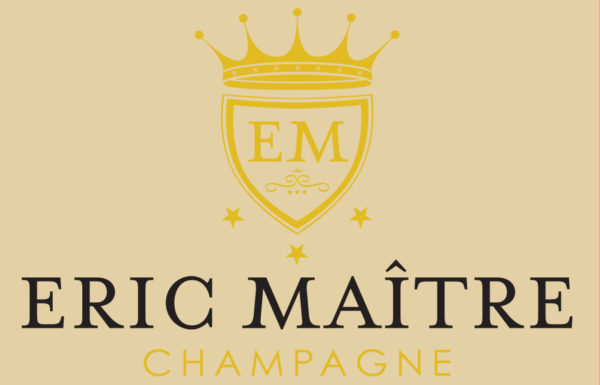
The Estate
Champagne Eric Maître has been a family-owned business since the 1860s, dedicated to preserving the age-old traditions of Champagne-making in the Côte des Bar. Thanks to the hard work and dedication of Eric Maître, his wife Daniella, and the entire Maître family, today the estate is an award-winning Maison de Champagne producing authentic and high-quality Champagnes made from Pinot Noir cultivated in Celles-sur-Ource.
Located in the heart of Aube in the southern part of the Champagne region, Celles-sur-Ource is a historic and privileged place. Blessed with a terroir rich in clay-limestone, it is ideal for the production of fresh and delicate Champagne. About 400 hectares of vines are grown by the Champagne makers of the village, which makes Celles-sur-Ource one of the thriving centers of the Champagne Aubois. Each year, the village produces more than 3 million bottles of Champagne.
Eric Maître took over his family estate at the end of the 1980s and launched his brand in 1995. He cultivates approximately 8 hectares of Pinot Noir vines and uses sustainable farming methods as much as possible to respect the health of the consumer and to protect this extraordinary terroir.

Champagne Brut Tradition NV
Soil: Clay-limestone
Grape Variety: 100% Pinot Noir
Average Age of Vines: 40 years old
2021 Release Vintage Blend: From the 2017 vintage, as well as grapes from the 2 preceding years.
Vinification: Natural settling. Alcoholic fermentation for approximately 2 weeks at low temperature. Vinification on lees. Malolactic fermentation natural and complete. Minimal use of sulfur. Prise de mousse at low temperature.
Aging: Remains in the cellar for 3 years at a high level.
Dosage: 8 g/L
Tasting Notes: It has a floral and fruity bouquet, with great freshness and a definite minerality on the palate. Notes of cherry, stone, brioche, and honey. It is complex, structured, and vibrant without being harsh. Lovely persistence on the finish.

Champagne Brut Rosé
Overview: These same vineyards have been cultivated since 1869 by the Maître family, at the heart of Côte des Bar, on clay-limestone soils with the best exposure. All the plots of the vineyard are vinified separately before blending.
Grape Variety: 100% Pinot Noir
Average Age of the Vines: 40 years old
Vinification: This Brut Rosé is made using the saignée or “bleeding” method; it is more labor intensive than the typical assemblage process. The pigment from the red grape skins is released into the blend during the pressing, and the longer the skin contact, the darker the Champagne will be. A Brut Rosé de Saignée will typically be a darker color than an assemblage Brut Rosé. Maître’s Rosé is vatted for 3 days. Alcoholic fermentation lasts approximately 2 weeks at low temperatures. Vinification on the lees. 100% malolactic fermentation. Minimal use of sulfur. “Prise de Mousse” at low temperature.
Aging: Matured in bottle for a minimum of 20 months.
Winemaker Tasting Notes: “This Champagne Rosé is produced using the ‘saignée’ method. It is characterized by its authenticity, its beautiful raspberry pink color with orange highlights, and its delicious nose with delicate notes of red fruit. There is intense freshness on the palate with red fruit aromas (raspberry, Morello) and final notes of citrus fruit.”
Food Pairings: Ideal as an aperitif or with dessert, like fruit salad or a fruit crumble.
Dosage: 11 g/l
Serving Temperature: 8°C
Champagne François Secondé

Overview
For centuries, Sillery has been known as the region which produces some of the most sought after Champagnes in the world. Right at the heart of this renowned terroir, you will find Champagne François Secondé, a vineyard covering an area of just over 5 hectares and located in Sillery, Mailly-Champagne, Puisieulx, and Verzenay. François Secondé is an independent wine maker (vigneron independant), and the only récoltant manipulant (one whose grapes are not sourced, but come from his own vineyard) and producer of pure Sillery Champagne.
History of the Vineyard
At the age of 14, François Secondé left school and started to work as an apprentice in a vineyard. He bought his first vineyard in 1972, and in 1976, he increased his plot to 3 hectares. With the help of his wife Anne-Marie, he started producing his own Champagne. Today, Champagne François Secondé vineyard is 5.5 hectares and harvests two grape varietals: 2/3 Pinots noir, and 1/3 Chardonnay. The vines are 37 years of age on average and are farmed in a sustainable way with respect to both nature and man. As of 2023, François Secondé uses zero herbicides or insecticides on the entire vineyard.
History of Sillery
Sillery became renowned at the beginning of the 17th century thanks to Nicolas Brûlart–owner of Sillery Castle and vineyard. He was Henry IV’s Chancellor and this connection helped him to get his wine tasted by the king and his inner circle. At its peak in the 18th century, Sillery’s reputation was reported by Edme Béguillet, attorney to the parliament of Dijon, oenologist, and famous for his dislike of Champagne’s wine makers. He said of Sillery wines that “their quality is so superior that only the king deserves them”.

Champagne Brut Grand Cru NV
Cru: Sillery
Average Age of Vines: 38 years
Location: Montagne de Reims
Grape Varietals: 2/3 Pinot Noir, 1/3 Chardonnay, and 30% reserve wines
Vinification: Malolactic fermentation
Maturation: 18-24 months with manual riddling
Base Vintage: 2017
Dosing to Disgorgement: 8 g/l
Characteristics: Golden yellow hue, highlighted by a string of sparkling bubbles. The nose is mineral and floral with notes of freshly baked pastries. The palate is balanced with hints of rich, lightly toasted brioche, and exotic fruit. To be served chilled at a temperature of about 8 °C.
Awards:
- Silver Medal Decanter World Wine Awards 2019
- Silver Medal 2012 Independant Winemakers Competition
- Silver Medal 2014 Brussels World Competition

Champagne Brut Rosé NV
Cru: Sillery
Average Age of Vines: 38 years
Location: Montagne de Reims
Grape Varietals: 100% Pinot Noir with 20% reserve wines
Vinification: Malolactic fermentation
Maturation: 24 months with manual riddling
Base Vintage: 2017
Dosage to Disgorgement: 8 g/l
Yield: 4,000 bottles per year
Characteristics: Clean, well-defined rosé; floral, subtle, quite pure, with a creamy texture on the palate. The bubbles have finesse and linger on the tongue. Serve as an aperitif or with desserts made with red fruit.
Awards:
- Gold Medal 2014 Paris General Agriculture Competition
- Gold Medal 2015 Paris General Agriculture Competition
- Silver Medal 2015 Independant Winemakers Competition

Sermiers 1er Cru Blanc de Blancs
Cru: Sermiers 1er Cru
Average Age of the Vines: 20 years old
Location: This plot is located on the north side of the Montagne de Reims
Grape Varieties: 100% Chardonnay
Vinification: Completed in tanks with the use of malolactic fermentation.
Aging: Aged in vats and in barrels. 18 months in cellar. Manual riddling.
Annual Yield: 1,000 bottles per year
Tasting Notes: Mineral and floral, with a creamy texture and very fine bubble.
Serving Suggestion: Perfect when served as an aperitive or with a meal. Serve in large glasses in order for the Champagne to be fully expressed.

Champagne Blanc de Blancs Sillery Grand Cru Millésime
Cru: Sillery Grand Cru
Location: Montagne de Reims
Age of the Vines: 47 years old (this Champagne is produced from 1 single plot)
Grape Varieties: 100% Chardonnay
Vinification: Malolactic fermentation in tanks followed by a period in barrels. No filtration.
Aging: The wine is left to rest in the cellar for a minimum of 36 months with manual riddling.
Tasting Notes: Clear, brilliant golden color with intense and persistent bubbles. The bouquet is powerful and fresh with aromas of acacia, candied fruit, and honeysuckle. The mouth is elegant, with notes of white flowers, spice, and citrus. Very beautiful aromatic persistence; balanced and harmonious.
Serving Suggestion: Excellent as an aperitif or to accompany lobster or white meats.

Champagne Blanc de Noirs Sillery Grand Cru La Loge
Cru: Sillery Grand Cru
Location: Montagne de Reims; this cuvée is produced from the finest Pinot Noir plots in Sillery
Average Age of the Vines: 38 years old
Varietal Blend: 100% Pinot Noir
Vinification: Malolactic fermentation in tanks, followed by a brief period in barrels.
Aging: 18-24 months with manual riddling
Average Yield: 2,000 bottles/year
Tasting Notes: Golden yellow color. The fineness of this Champagne is evident beginning with the quality of the bubbles which form a persistent mousse at the rim. Powerful yet refined on the nose, the bouquet opens with notes of red fruit and fresh pastries. On the palate, there is a delightful effervescence which complements the unctuous, fruity quality of this Champagne. Very well balanced cuvée which can be consumed either as an aperitif or as an accompaniment to the main meal.
Awards:
- Silver Medal IWC (International Wine Challenge) 2019
- Silver Medal DECANTER World Wine Awards 2019

Champagne Puisieulx Grand Cru Les Petites Vignes
Location: The village of Puisieulx was classified as Grand Cru; the vineyard has a surface area of less than 18 hectares and is positioned towards the southeast. The soil is light and chalky.
Average Age of Vines: 47 years
Grape Varietals: 50 % Chardonnay, 50 % Pinot Noir
Vinification: Alcoholic fermentation and malolactic fermentation
Maturation: 24 months minimum
Characteristics: Intense nose and fine aromas of mature fruit with a touch of vanilla. Delicate on the palate with a beautiful minerality

Coteaux Champenois Sillery Blanc
Cru: Sillery
Grape Varietals: Chardonnay and Pinot Noir from Sillery
Vinification: Vinification in wooden vats and barrels with malolactic fermentation; unfiltered
Maturation: Aged in wooden barrels for at least one year before bottling
Characteristics: Golden color, aromas of citrus, vanilla, and exotic fruit on the nose. The attack is fresh, and this vintage holds its body well on the finish. Pairs well with cold starters, oysters, as well as fresh chevre. Served chilled at 7-8 ° C.

Coteaux Champenois Sillery Rouge
Cru: Sillery Grand Cru
Grape Varietals: 100% Pinot Noir
Average Age of the Vines: 60 years old
Location: Montagne de Reims
Vinification: Long fermentation with 2 pumpings per day; Vinification in wooden vats and barrels with malolactic fermentation; Unfiltered.
Maturation: Aging in wooden barrels and vats for at least one year
Characteristics: Ruby red color; this wine is fresh, fruity, and light. Drink now with grilled meat or red fruit desserts. Served chilled at 8 °C

Clavier Brut
Grape Varieties: 65% Chardonnay, 35% Pinot Noir
Terroir: Montagne de Reims
Average Age of Vines: 42 years old
Vinification: Malolactic fermentation
Cellaring: 24 months
Production: 2,000 bottles per year
Tasting Notes: A complex palette of aromas dominated by citrus fruit and slight butter notes.
Champagne Lacourte-Godbillon (Biodynamic)
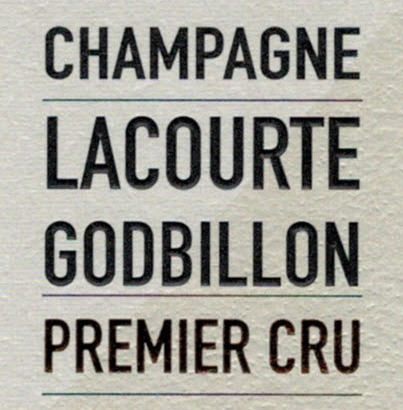
The Estate
Located in the Premier Cru village of Écueil on the west bank of the “Petite Montagne de Reims”, these vines have belonged to the Lacourte & Godbillion families for generations. The very first planting of Champagne vines was prior to 1947, however Jean-Guy Lacourte and Claudine Godbillon had their very first harvest under the name Lacourte-Godbillion in 1968. In 2006, almost 40 years later, Richard Desvignes and Geraldine Lacourte decided to leave their executive city jobs to come back to the family vineyard. This new life of wine making has been a total revelation for them, and they strive to follow the philosphy of their ancestor, Jean-Guy Lacourte: “Only the highest quality grapes can produce a high quality wine.” The estate now includes 20.5 acres of vines (95% planted in Écueil, 5% in the neighboring village of Les Mesneux).
Cultivation
The vineyards are worked exclusively by Lacourte-Godbillion’s team. They plow during the winter to break up the soil, and mow the grass between the vine rows to maintain and develop soil vitality. The vineyards are certified organic and demeter; there is no use of any pesticides, weedkillers, or other anti-botrytis treatments. Their goal is to control the number of buds and shoots so that new growth is consistent and well spaced out. Care is taken to separate out the shoots; keeping the vine canopy well aerated with no overcrowding of leaves or grape bunches results in only the highest quality grapes. Harvest is done manually.
Surface Area: 8 ha
Average Age of Vines: 30 years old
Grapes Varietals: 85% Pinot Noir, 15% Chardonnay
This particular terroir is characterized by an incredibly diverse sub-soil. Some sections are predominantly sandy over a layer of deep chalk, others are composed of “Sparnacian” clay and shallow chalk at the bottom of the hillside, similar to the soils of Les Mesneux.
Vinification
Lacourte-Godbillon has a clear vision for their winery: a wine must reflect its terroir. The wood for the oak barrels either comes from Ecueil’s forest or from Champagne-Ardenne. The harvest from each plot is pressed and vinified separately and the juice is not pumped, but moved by gravity as far as possible to allow the resulting wine to retain its intrinsic qualities.
Fermentation
The fermentation process is temperature-controlled and monitored daily. The wine is left in tank or barrel in contact with the lees for the autumnal season. No racking is done in order to develop complexity and unique personality. For the wine fermented in oak barrels, no stirring or filtering is carried out. The chilling process is done outside to utilize the seasonal cold temperatures.
Maturation
The bottles are aged in the cellar for 30 months and up to 7 years. This is followed by an average resting time of 3-6 months after the yeast deposits have been removed by disgorgement. The optimum dosage for each wine in each year is decided by several trial tastings. The objective is to find the best possible balance as each wine is a living being with its own character.

Champagne Brut 1er Cru Terroirs d'Écueil
Grape Blend: 85% Pinot Noir, 15% Chardonnay
Viticulture: The soil is worked mechanically; plowing under the vines, and grass between the rows.
Harvest: Manual
Average Age of the Vines: 30 years old
Vinification: Temperature controlled stainless steel tanks, malolactic fermentation carried out
Aging: Minimum of 30 months on lees and 3 months after disgorgement
Cellaring Potential: 3-5 years
Serving Suggestion: An excellent choice for all occasions, ideal served as an apéritif. Serve at 8°-9° C.

Brut Rosé
Grape Blend: 100% Pinot Noir
Cru: Ecueil
Average Age of the Vines: 25 years old
Viticulture: Ploughing under the vines and grass between the rows.
Vinification: 90% in thermo-regulated stainless steel tanks, 10% in oak barrels (228l).
Aging: Minimum of 4 years on lees and 6 months after disgorgement.

Champagne Millésime 1er Cru
Grape Blend: Pinot Noir, Chardonnay
Soil: Sand and clay sub-soil. Mid-slope position
Average Age of the Vines: 30 years old
Viticulture: The soil is worked mechanically.
Harvest: Manual harvesting.
Vinification: Temperature controlled stainless steel tanks, malolactic fermentation prevented for the Chardonnay.
Aging: 6 years minimum in our cellars.
Aging Potential: 5 years
Tasting Notes: Golden straw color. The nose has intense aromas of stone fruits (mirabelle plum), toast, and brioches notes. On the palate, this wine is ample and intense on the attack followed by freshness and tension with notes of citrus.
Food Pairings: Veal chops cooked medium-rare, sea bass
Serving Temperature: 10°-12° C

Champagne 1er Cru Chaillots
Grape Blend: 100% Pinot Noir
Vineyard: “Chaillots” plot planted in 1966, massal selection of pinot d’Ecueil, sand on the surface and tuf in the depth. South exposition, ploughing under the vines and grass between the rows.
Vinification: Fermentation in 300 l oak barrels, oak from Ecueil’s forest. No malolactic fermentation. Use of gravity exclusively, not filtered, not fined, natural cold stabilization.
Aging: Minimum of 48 months on lees and 6 months after disgorgement.
Tasting: A lovely balance of yellow plum fruit and an incisive, well-judged structure from the barrel fermentation. Open and long texture. Lily and smoke and the whiff of baking, with a fresh lemon-oil note on the end.

Champagne 1er Cru Chaillots Hautes Vignes
Grape Blend: 100% Chardonnay
Vineyard: Mid-slope “Chaillots” and “Hautes Vignes” plots, aged 40 years, ploughing under the vines and grass between the rows.
Vinification: Fermentation in 228 liter oak barrels. No malolactic fermentation. Use of gravity exclusively, not filtered, not fined, natural cold stabilization.
Aging: Minimum of 36 months on lees and 6 months after disgorgement.
Tasting Notes: Gentle nose of lemon-butter and smoldering sweet smoke. Starts urgently, gaining instant attention, so fresh and dry! Complex and creamy. Gorgeous, sweet, sponge-cake and almond notes to sign off.

Champagne 1er Cru Extra Brut M.A.M. Monts Âme-Migerats
Vineyard Plots: This Champagne is produced from plots in Ecueil and Mesneux: Mont Âme & Migerats.
Soil: Chalk (Mont Âme) and light clay (Migerats)
Average Age of the Vines: 55 year old Sélection Massales
Grape Blend: 100% Pinot Noir
Vinification: Base wine aged in 300-liter barrels after pressing and spontaneous fermentation, no malo. No fining or filtration.
Aging: Aged for five years on lattes.
Tasting Notes: Complex with lemony, buttery, and pastry notes. Vibrant saline finish.

Champagne 1er Cru Mi-Pentes
Grape Blend: 100% Pinot Noir
Vineyard Plots: Mid-slope plots, 40 years average age, ploughing under the vines, and grass between the rows.
Vinification: 60% in thermo-regulated stainless steel tanks, 40% in oak barrels (228l), no malolactic fermentation.
Aging: Minimum of 40 months on lees and 6 months after disgorgement.
Tasting Notes: Concentrated, intense nose of yellow fruits, sweet spice. Precise structure and meaty substance of Pinot d’Ecueil. Vibrant, high pitched, and persistent texture. Accomplished modern champagne, wholly expressive of Ecueil.
Champagne Rodez (Biodynamic)
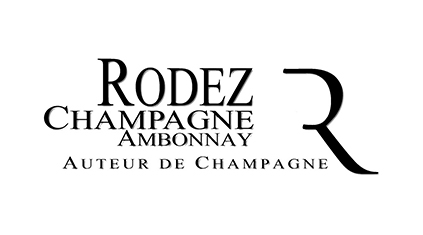
The Estate
The Rodez family has been making wine for nine generations, beginning as far back as 1757. The estate of Champagne Rodez is located in the Grand Cru that is Ambonnay, the heart of Pinot Noir country, and spans an area of 6.12 hectares. The property consists of 35 parcels of vines, and the grape varietals planted are 62% Pinot Noir and 38% Chardonnay. The vineyards are planted at a fairly high altitude (about 130 meters), and are situated on a clay-limestone soil, two factors which are ideal for growing Pinot Noir.
Eric Rodez, current vineyard manager and head oenologist for the estate, has worn many hats in his day. Not only was he at one time the Mayor of Ambonnay, but he was also formerly an oenologist at Krug where he developed his winemaking/blending methods that would later be employed on his own estate. Eric, along with his wife Martine and son Mickael, manages all aspects of the winemaking process at Champagne Rodez.
It was while traveling in Alsace and other wine growing regions that Eric gained an appreciation for organic and biodynamic vineyard practices. It is through these methods that he believes the resulting wine truly expresses the characteristics of the terroir. Eric hesitates to use the word organic, because he is not certified, but as a grower he uses no pesticides, fertilizers, or synthetic sprays on his plants. In 2012, Champagne Rodez was the first French agricultural domaine to receive the Haute Valeur Environmentale certificate for their efforts towards organic and biodynamic farming and water management on the estate. In the vineyard, Eric plows his soils and limits his yields through careful pruning. Vinification is done in either oak barrels or enameled steel vats. The annual production of the estate is about 45,000 bottles.
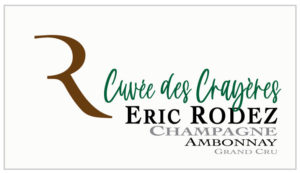
Champagne Grand Cru Cuvée des Crayères
Overview: Champagne of body and spirit made by the marriage of 60% Pinot Noir and 40% Chardonnay. Straight, round, generous, the Cuvée des Crayères is made on average from a dozen different wines from 4 to 5 different vintages, with 50 to 55% of the wines vinified in small oak barrels, with 65 to 70% reserve wines helping to bring homogeneity.
Grape Varieties: Pinot Noir, Chardonnay
Vineyard Plots: Terroir d’Ambonnay-Les Grandes Ruelles, Les Bouités, La pierre aux Larrons, Les Cheminots, Les Secs, Les Fournettes, Les Agusons, Les Beurys, Les Hauts Tourets
Average Age of the Vines: 30 years old
Vinification: Out of tank for 42%, out of barrels 58%. Partial malolactic fermentation (with malo 65% and without 35%)
Tasting Notes: This Champagne has a delightful golden hue with luminous highlights. The nose reveals floral and mineral notes and, upon aeration, red and white fruit savors. The palate is fresh and generous, playing with notes of spring berries.
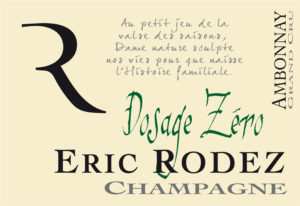
Champagne Grand Cru Dosage Zéro
The Vines: In the vineyard, Eric plows his soils and limits his yields through careful pruning.
Grape Varieties: Pinot Noir, Chardonnay
Vinification: Vinification takes place in either oak barrels or enameled steel vats.
Aging: 80% of the wines are matured in small oak barrels and are composed of 30% reserve wines
Tasting Notes: Golden color. Long, complex, but also sensual, the nose has hints of white fruit. The palate is creamy with notes of exotic fruit on the finish. This cuvee combines power and strength without added sugar.
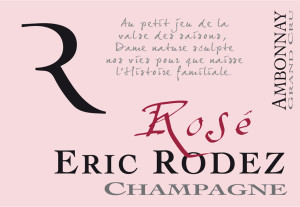
Champagne Grand Cru Rosé Brut
Overview: This brut Champagne is the achievement of the association of the Pinot Noir of maceration (40%), Pinot Noir (30%) and Chardonnay (30%), the latter bringing delicacy and elegance. The winemaker also resorts to the stored wines, up to 40%.
Grape Varieties: Pinot Noir of maceration, Pinot Noir, Chardonnay
Vineyard Plots: Les Grandes Ruelles, Le Moulin, Les Bouités, La Pierre aux Larrons, Les Cheminots, Les Hauts Tourets
Average Age of Vines: 32 years
Vinification: Out of tank for 20%, out of barrels 80%. Partial malolactic fermentation (with malo 49% and without 51%)
Tasting Notes: The color is marked by the maceration of Pinot Noir. The nose is complex, powerful, long, with a predominance of red berry notes. The palate is smooth and powerful, with hints of subtle oak.
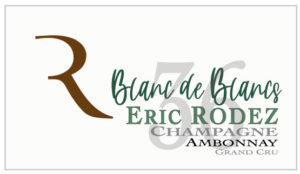
Champagne Grand Cru Blanc de Blancs
Overview: This is a brut Champagne produced exclusively out of several harvests of Chardonnay, from different years. For this cuvée, the winemaker usually blends 5 or 6 vintaged productions in order to ensure the same delicacy along the years. This Champagne is very flowery, delicate, and sensual.
Vineyard Plots: Terroir d’Ambonnay, “Regions of Heart in Mid-Coast”: Les Secs, La Loge, Les Genettes, Les Morins, Les Champsaults. “Regions of Spirit”: Les Crayères, Les Agusons, Les Cheminots, La Grande Ruelle
Grape Variety: 100% Chardonnay
Average Age of the Vines: 31 years old
Vinification: Out of tank for 18%, out of barrels 82%. Partial malolactic fermentation (with malo 20% and without 80%)
Tasting Notes: It is of a subdued gold color, with touches of green. The nose is both fruity and floral, and expresses hints of chestnut after swirling. The attack is good, vinous, with an elegant gustatory persistence.
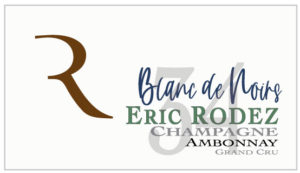
Champagne Grand Cru Blanc de Noirs
Overview: This brut Champagne is produced from Pinot Noir harvests only. For this cuvée, the winemaker generally blends 5 to 6 vintaged productions to make sure the cuvée will keep its character. It is even better-balanced and meatier than the Blanc de Blancs. It is complex, with a slight hint of red fruit, very elegant, offering a longer finish.
Grape Varieties: 100% Pinot Noir
Vineyard Plots: Terroir d’Ambonnay, “Regions of heart in Mid-Coast”: Les Beurys du Haut, Les Goisses, Les Secs, Les Fournettes, Les Genettes, Les Hauts Touret, Les Vaux Saint Basles. “Regions of Spirit”: La Pierre aux Larons, Les Bouités, Les Grandes Ruelles
Average Age of the Vines: 33 years old
Vinification: Out of tank for 20%, out of barrels 80%. Partial malolactic fermentation (with malo 30% and without 70%)
Tasting Notes: Light gold in color, with shades of copper. It offers a fruity nose, together with flavors recalling spring after rotation. The attack is dense, meaty, filling the palate with flavors of citrus fruit.
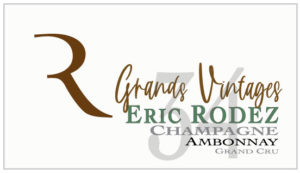
Champagne Grand Cru Cuvée des Grands Vintages
Overview: This Champagne is exclusively made out of the juices from several years’ first pressings of the best vintaged productions. Among the choices of wines offered by Champagne Rodez, the Cuvée des Grands Vintages is the Champagne one wishes to offer to celebrate the important moments of one’s life, with its golden color, with hints of copper and sometimes of light orange.
Grape Varieties: Pinot Noir, Chardonnay
Average Age of the Vines: 34 years old
Vineyard Plots: Les Secs, Les Beurys, Les Goisses, Les Genettes, Les Vaux Saint Basle, Les Fournettes, Le Noyer Saints Pys, Les Morrins
Vinification: Out of barrels 100%; no malolactic fermentation
Tasting Notes: The expressive nose will immediately reveal enticing aromas of toffee and marmalade. It benefits from a good cellaring potential, the elegance of which will be appreciated through a full, powerful, and flavorsome palate.
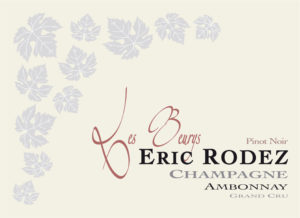
Champagne Grand Cru Pinot Noir Les Beurys
Overview: This wine is the culmination of work begun over 25 years ago and expresses the soul of the noble terroir from which it is produced. The role of the winemaker is limited to respecting the integrity of and working with the terroir.
Grape Varieties: 100% Pinot Noir
Vineyard Plots: Les Beurys
Exposure: East
Average Age of the Vines: 35 years old
Vinification: In small oak barrels, no malolactic fermentation, no artificial refrigeration, no filtration
Tasting Notes: This wine has a sensuality which comes from the terroir and is supported by a minerality that comes from the chalk present in the soils
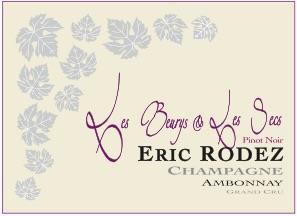
Champagne Grand Cru Pinot Noir Les Beurys & Les Secs
Grape Variety: 100% Pinot Noir
Vineyard Plots: Les Beurys 95%, Les Secs 5%
Exposure: Les Beurys – East; Les Secs – South.
Soil before Chalk: 35 cm
Average Age of the Vines: 38 years old
Vinification: 100% in small oak barrels. No malolactic fermentation, no industrial cold stabilization, or filtration.
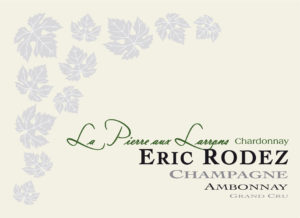
Champagne Grand Cru Chardonnay La Pierre Aux Larrons
Overview: The result of over 25 years of work on the domain, the «Lieux Dits» are Champagne cuvees that reveal the complexities of the soil from which they originate. The role of the winemaker is limited to respecting the original musical integrity. The name of the plot, “La Pierre aux Larrons,” refers to a stone located in a wasteland, hearkening back to the Gallo-Roman era.
Grape Varieties: 100% Chardonnay
Soil: 55 cm deep layer of soil before chalk
Exposure: East
Average Age of the Vines: 42 Years
Harvest: October
Vinification: 100% in small oak barrels. No malolactic fermentation, no industrial cold stabilizing, no filtration – but a lot of passion.
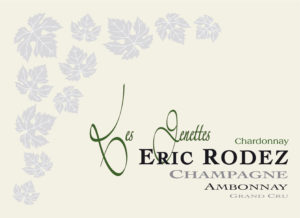
Champagne Grand Cru Chardonnay Les Genettes
Grape Varieties: 100% Chardonnay
Vineyard Plots: Les Genettes is a plot in Ambonnay with a southeastern exposure and slightly deeper soils than Les Beurys.
Exposition: Southeast
Soil Before Chalk: 45 cm
Average Age of the Vines: 39 years old
Harvest: September
Vinification: In small oak barrels, no malolactic fermentation, no artificial refrigeration, no filtration
Aging: 5 years on the lees
Post-Disgorgement Aging: 1 Year
Tasting Notes: Fresh notes of crisp apple, zesty grapefruit, and balanced oak at the start. 5 years of aging on the lees lends a roundness and lovely texture to the mouthfeel. Elegant minerality and a long, lingering finish.
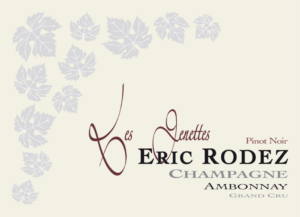
Champagne Grand Cru Pinot Noir Les Genettes
Overview: This wine is the culmination of work begun over 25 years ago and expresses the soul of the noble terroir from which it is produced. The role of the winemaker is limited to respecting the integrity of and working with the terroir.
Grape Varieties: 100% Pinot Noir
Vineyard Plots: Les Genettes is a plot in Ambonnay with a southeastern exposure and slightly deeper soils than Les Beurys.
Average Age of the Vines: 41 years old
Vinification: In small oak barrels, no malolactic fermentation, no artificial refrigeration, no filtration
Tasting Notes: Tasty and sweet, this wine sees all its generosity enhanced by minerality provided by the methods of the winemakers.
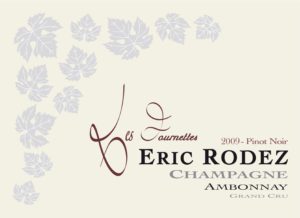
Champagne Grand Cru Pinot Noir Les Fournettes
Vineyard Plots: Les Fournettes is a southeast-facing parcel on the western side of the village where the topsoils are deeper, about 65 centimeters.
Grape Varieties: 100% Pinot Noir
Average Age of the Vines: 27 years old
Tasting Notes: Chalky minerality, elegant vinosity, and fruitiness.
Vinification: Vinified in small oak barrels; no malolactic fermentation
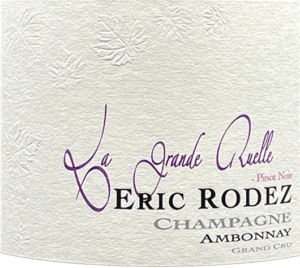
Champagne Grand Cru Pinot Noir La Grande Ruelle
Overview: This Champagne is a pure expression of this single plot of terroir called La Grande Ruelle.
Exposure: East
Average Age of the Vines: 35+ years old
Grape Variety: 100% Pinot Noir
Vinification: In small oak barrels. No malolactic fermentation, no cold stabilization, no filtration.
Aging: Sur lies for 5 years.
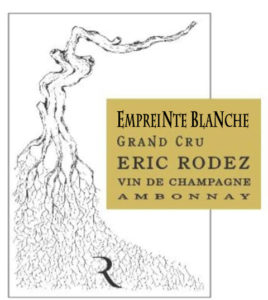
Champagne Grand Cru Cuvée Empreinte Blanche
Overview: Always vintage, this Champagne is produced from a blend of 5 to 7 parcels of the domain. Empreinte expresses the winemaker’s vision of the vintage in Ambonnay.
Vinification: In small oak barrels, no malolactic fermentation, no cold stabilization, no filtration.
Grape Varieties: 100% Chardonnay
Vineyard Plots: Le Noyer Saint Pys, Les Secs, Les Agusons, Les Champsaults
Average Age of the Vines: 39 years old
Tasting Notes: The single grape variety of Empreinte de Terroir seeks only to emphasize the characteristics of the vineyard terroir, across the vineyards, and waltzing across the vintages. For some vintages, the comparison of varieties bring an extra dimension. Clear, bright gold color. The bouquet expresses floral notes and fragrances of young, white peach. The finish is long with lovely, woodsy notes of bark and vanilla.
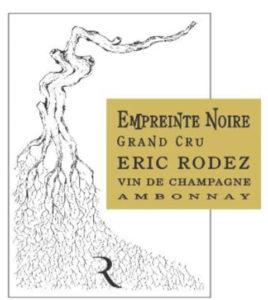
Champagne Grand Cru Cuvée Empreinte Noire
Overview: Always vintage, this Champagne is produced from a blend of 5 to 7 parcels of the domain. Empreinte expresses the winemaker’s vision of the vintage in Ambonnay.
Grape Varieties: 100% Pinot Noir
Vineyard Plots: Les Gennettes, Les Beurys, La Goisse, Les Bouités
Average Age of the Vines: 42 years old
Vinification: 100% small oak barrels; no malolactic fermentation, no cold stabilization, no filtration.
Tasting Notes: The single grape variety of Empreinte de Terroir seeks only to emphasize the characteristics of the vineyard terroir, across the vineyards, and waltzing across the vintages. For some vintages, the comparison of varieties bring an extra dimension.
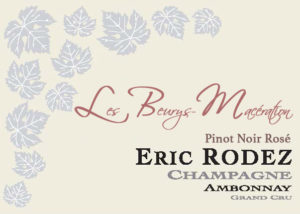
Champagne Grand Cru Rosé de Maceration Les Beurys
Grape Varieties: 100% Pinot Noir
Plot: Les Beurys
Exposition: East
Soil Before Chalk: 35 cm
Average Age of the Vines: 40 Years
Harvest: September
Vinification: Maceration for 3 days. 100% vinified in small oak barrels. No malolactic fermentation.
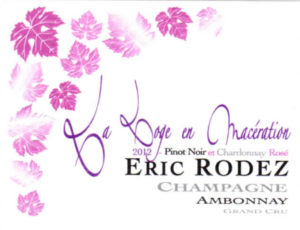
Champagne Grand Cru Pinot Noir & Chardonnay Rosé La Loge en Macération
Grape Varieties: 50% Pinot Noir, 50% Chardonnay
Vineyard Plots: Les Fournettes, Noyer Saint Pys
Exposition: South
Soil (before chalk): 55 cm
Average Age of the Vines: 42 years old
Harvest: September
Vinification: Maceration for 2 days. 100% in barrels. No malolactic fermentation.
Tasting Notes: Notes of ripened red and black fruits permeate the bouquet, complemented by an infusion of spices. This is an exceptionally elegant and delicate Champagne – perfect on its own or served as an aperitif.
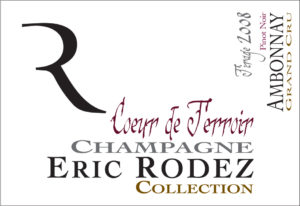
Champagne Grand Cru Pinot Noir Coeur de Terroir Tirage 2008
Grape Varieties: 100% Pinot Noir
Vineyard Plots: Les Beurys, Les Goisses, Les Secs, Les Fournettes, Les Genettes, Les Bas Tourets, Les Vaus Saint Basless, La Pierre aux Larrons, La Grande Ruelle
Average Age of the Vines: 32 years old
Bottling Date: Spring 2008
Vintage Blend: 45% 2007, 30% 2006, 13% 2005, 8% 2004, 2% 2002, 2% 2000
Vinification: 75% in barrels. Partial malolactic fermentation (35%)
Dosage: 4 g/L
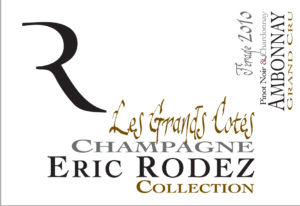
Champagne Grand Cru Pinot Noir & Chardonnay Les Grands Cotés Tirage 2010
Bottling Date: Spring 2010
Grape Variety: 58% Pinot Noir, 42% Chardonnay
Vineyard Plots: Terroir d’Ambonnay – Les Grandes Ruelles, Le Moulin, Les Champsaults, Le Noyer Saint Pys, Les Secs, Les Fournettes, La Pierre aux Larrons, Les Agusons, Les Beurys
Average Age of the Vines: 29 years old
Vintage Blend: 42% 2009, 26% 2008, 11% 2007, 9% 2006, 10% 2005, 2% 2004
Vinification: 35% in barrels. Partial malolactic fermentation (35%)
Dosage: 5 g/L
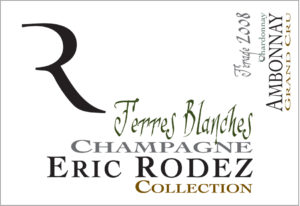
Champagne Grand Cru Chardonnay Terres Blanches Tirage 2008
Grape Variety: 100% Chardonnay
Vineyard Plots: Terroir d’Ambonnay – Le Noyer Saint Pys, Les Morins, Les Genettes, Les Champsaults, Les Secs, Les Bermonts, Les Crayeres, Les Agusons, Les Cheminots.
Average Age of the Vines: 32 years old
Vintage Blend: 41% 2007, 20% 2006, 17% 2005, 15% 2004, 3% 2003, 4% 2002
Vinification: 70% in barrels. Partial malolactic fermentation (30%)
Dosage: 5 g/L
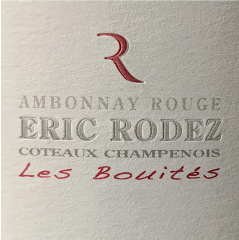
Coteaux Champenois Ambonnay Rouge Les Bouités
Overview: Long before it was famous for the effervescence of its wines, Champagne produced still wines. In the 17th century, the vineyard extended over more than 55,000 hectares, and white wines represented the majority of production. With this red wine, Coteaux Champenois, the winemaker would like to express other sensory notes derived from the vineyard.
Grape Variety: 100% Pinot Noir
Vineyard Plots: Les Bouités
Harvest: September
Vinification: 100% in oak barrels
Tasting Notes: Elegant, fruity, and fresh. The tannins are well balanced and the mouthfeel is remarkable.
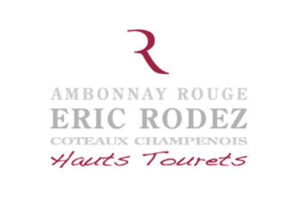
Coteaux Champenois Ambonnay Rouge Hauts Tourets
Overview: Long before it was famous for the effervescence of its wines, Champagne produced still wines. In the 17th century, the vineyard extended over more than 55,000 hectares, and white wines represented the majority of production. With this red wine, Coteaux Champenois, the winemaker would like to express other sensory notes derived from the vineyard.
Grape Variety: 100% Pinot Noir
Vineyard Plots: Les Hauts Tourets
Vinification: 100% in oak barrels
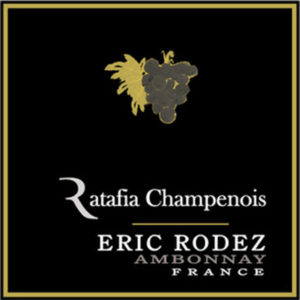
Ratafia Champenois
Winemaker Tasting Notes: “Ratafia is an authentic moment of pure sweetness and pleasure. First discovered in the 13th century, It is made traditionally from Champenois grape juice with the addition of alcohol. Real amber nectar, Ratafia de Champagne reveals a nose full of finesse with pear and honey aromas. Its rounded, silky, and agreeably vivacious mouthfeel leaves an impression of freshness all the way up to a long finish. Lightly spiced and brimming with fruit flavors.”
Release Date: Spring 2022
Grape Variety: 100% Pinot Noir
Vintage Blend: A blend of vintages between 2015 and 2020.
Aging: 100% in barrel.
Charlotte et Antoine Kreydenweiss (Organic)

The Estate
Antoine and his wife Charlotte have developed a second range of wines for Domaine Kreydenweiss: Lune à Boire, which is produced from grapes which are purchased from partner organic winegrowers with the same philosophy as Domaine Kreydenweiss.
This story was born in 2014, with Luc, a biodynamic winemaker, from whom Kreydenweiss bought their first grapes with the aim of producing Crémant. Then in 2015, with organic winemaker François, who provided the Pinot Noir used to create the Pinot Boir cuvée under the Marc Kreydenweiss label.
In 2021, the time came for Kreydenweiss to unleash their imagination and produce a range of unpretentious wines to share, and the Lune à Boire range was born!
The name Lune à Boire was inspired by 4 scratch cards on the wall of Kreydenweiss’ living room representing moons with different emotions and facial expressions, highlighted on old 45 vinyls and stuck on old aluminum boxes of film reels. Strasbourg artist Nathyi, with whom Kreydenweiss have already worked before, designed the labels. His work is totally compatible with the overall vision for Lune à Boire.
Gentle and free winemaking, with complete simplicity. No limits in the way of doing things, blending terroir, grape variety and even vintage, the only limit is the quality and expression of the Alsace terroirs in the bottle.
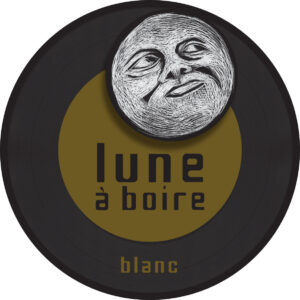
Lune à Boire Blanc
Appellation: Alsace
Type of Wine: Fruity dry white wine
Grape Varieties: Pinot Blanc, Pinot Auxerrois, Sylvaner, Riesling, Pinot Gris, Gewurztraminer
Soil: Blend of Alsatian terroirs
Certification: Organic farming by Ecocert
Vinification: Slow pressing of whole bunches, alcoholic and malolactic fermentation with indigenous yeasts, ageing on lees in oak foudres for at least one year before bottling.
Tasting Notes: Fruity nose, dynamic, juicy and round palate. An accessible and unpretentious wine, to open with friends.
Food Pairings: Aperitif, fish, charcuterie, cheese
Serving Temperature: 10-12 °C
Cellaring: To drink. Potential 5 years
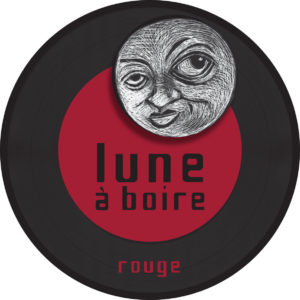
Lune à Boire Rouge
Appellation: Alsace
Type of Wine: Red fruity wine
Grape Varieties: Pinot Noir. These grapes are purchased from partner winegrowers with the same philosophy as ours.
Soil: Blend of Alsatian terroirs
Certification: Organic farming by Ecocert
Vinification: Maceration of whole bunches for a week followed by aging in foudres for one year. Unfiltered wine, no added sulphites.
Tasting Notes: A gourmet and fruity wine, which offers a beautiful texture in the mouth, a wine of pleasure to share with friends.
Food Pairings: Charcuterie, cheese, red meats
Serving Temperature: 14-16 °C, decant the wine before serving
Cellaring: To be consumed immediately, but can be cellared for up to 7 years.
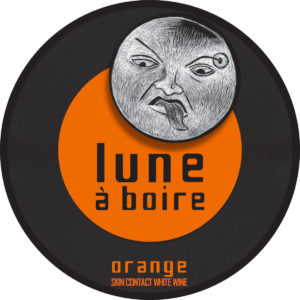
Lune à Boire Orange
Appellation: Alsace
Type of Wine: Orange wine
Grape Varieties: Gewurztraminer, Sylvaner. These grapes are purchased from partner winegrowers with the same philosophy as ours.
Soil: Blend of Alsatian terroirs
Certification: Organic farming by Ecocert
Vinification: Blend of maceration of whole bunches for one week (Gewurztraminer) and direct pressing (Sylvaner), alcoholic and malolactic fermentation with indigenous yeasts, aging on lees in oak demi-muids and foudres before bottling. Unfiltered wine, no added sulphites.
Tasting Notes: A powerful wine with spicy notes, balanced by its freshness and minerality. A wine of pleasure to open with friends.
Food Pairings: Cheese, spicy foods
Serving Temperature: 10-12 °C
Cellaring: To be consumed immediately, but can be cellared for up to 5 years.
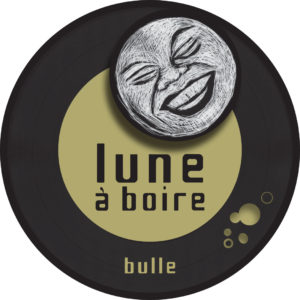
Lune à Boire Bulle
Appellation: Crémant d’Alsace
Grape Varieties: Pinot Blanc, Pinot Auxerrois, Chardonnay.
Soil: Blend of Alsatian terroirs. This wine is produced from purchases of grapes from partner winegrowers with the same philosophy as Kreydenweiss.
Viticulture: Organic farming by Ecocert.
Vinification: Slow pressing of whole bunches, alcoholic and malolactic fermentation with indigenous yeasts. No added sulphites.
Aging: On lees in oak foudres for one year before bottling for the second fermentation. Aging on the lees in bottle for 24 months.
Tasting Notes: A fine and delicate bubble, well balanced. Fresh and harmonious on the palate with aromas of ripe fruit.
Food Pairings: Aperitif, oysters
Serving Temperature: 8-10 °C
Cellaring: Keep in the cellar between 10-15°C. Cellaring potential of 5 years.
Château Ausone
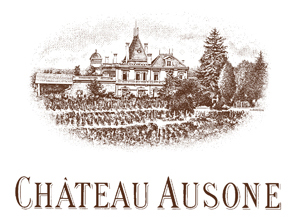
Overview
Ausone takes its name from the Roman poet Ausonius who owned over 100 acres of vineyard around Saint Emilion. It is said that he owned a grand villa in “Lucaniac” (the ancient name for the town), although whether it occupied the exact same location as the present vineyard is perhaps a romantic notion.
The vineyard itself covers just 7-hectares on a steep southeast-facing incline, three-quarters on the actual côte and the remainder atop the cellars around the church (you can just see the vines in the photo at the top of the page.) The soil is a mixture of limestone and clay, becoming sandier on the lower reaches where the grapes exhibit slightly lower acidity.
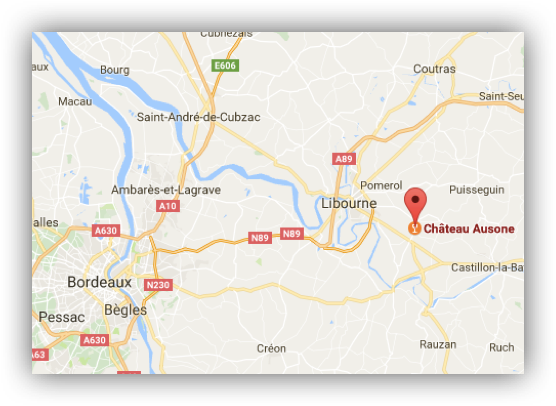
The Terroir
Chateau Ausone possesses one of the most prized terroirs in all of Bordeaux. It is quite hilly with clay limestone soils over a bed of Asteria limestone. The vines are, on average, 50 years old and enjoy a southeastern exposure.
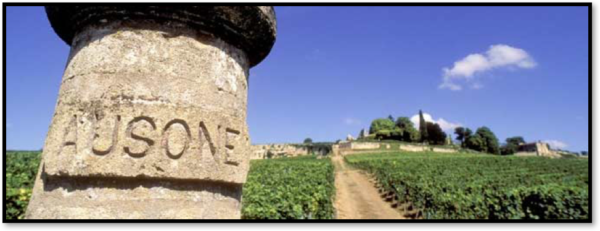
Acreage: 7 Ha
Soil: Clay & Limestone on a bed of Asteria limestone
Grape Varietals: 55% Cabernet Franc, 45% Merlot
Age of the vines: Since many vines escaped the devastating frosts of 1956, the average age is an impressive 45 to 50 years.
Plant-density: 6500-12000 plants/Ha
Average Yield: 32 hL/Ha
Vinification: Traditional; depending on the vintage, fermentation and maceration last between 3-5 weeks in thermoregulated wooden vats
Aging: Up to 2 years in French oak barrels with 100% new wood

Château Ausone Saint-Émilion
Plant Density: 6,500-12,600 plants/ha
Soil: Clay and limestone on a bed of Asteria limestone
Average Age of the Vines: 50 years old
Average Yield: 32 hl/ha
Annual Production: 18,000 bottles
Grape Varieties: 55% Cabernet Franc; 45% Merlot
Vinification: Traditional; depending on the vintage, fermentation and maceration last between 3-5 weeks in thermoregulated wooden vats
Aging: Up to 2 years in French oak barrels with 100% new wood
Serving Temperature: About 15°C
Food Pairings: This wine matches well with many different kinds of meat, as well as Asian dishes, and pasta

Chapelle d'Ausone
Plant Density: 6,500-12,600 plants/ha
Soil: Clay and limestone on a bed of Asteria limestone
Grape Varietals: 50% Cabernet Franc; 50% Merlot
Annual Production: 9,000 bottles
Vinification: Traditional; depending on the vintage, fermentation and maceration last between 3-5 weeks in thermoregulated wooden vats
Aging: Up to 2 years in French oak barrels with 100% new wood
Château Bouscaut
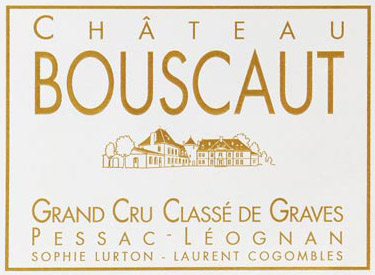
Overview
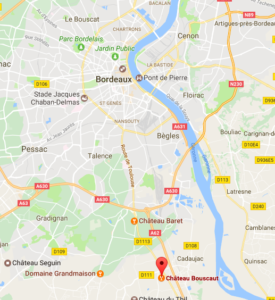
Château Bouscaut is one of the 6 Grands Crus Classés of Graves for both its white and red wines, in the Pessac-Léognan appellation. Sophie Lurton has been running Bouscaut, along with husband Laurent Cogombles for over 20 years.
Situated 34 m above sea level, Château Bouscaut’s vineyards spread out facing due south on the highest part of Cadaujac, a commune on the left bank of the Garonne River.
Château Bouscaut’s second-label wine is Les Chênes de Bouscaut. Château Lamothe-Bouscaut and Château Valoux are also part of the Bouscaut galaxy. They are all situated in the commune of Cadaujac.
History
Bouscaut’s vineyard has existed since the 17th century on the commune of Cadaujac, a Graves appellation at that time. Called Haut Truchon, it was renamed Château Bouscaut after the name on the land register in 1881 .
The various owners throughout the twentieth century were very dedicated to improving and transforming both the vineyard and the château. In the thirties, the domain was cited as being a model estate by the Chamber of Agriculture and a race horse called Château Bouscaut won first prize in the coveted Maisons Lafitte race. In the same period, a tower was added to the main residential building and cellars were erected next to it.
The winner of many medals, the wines of Château Bouscaut were widely recognized. Consecration came in 1953, when Bouscaut was awarded the envied status of Graves Cru Classé, for both its white and red wines.
In 1962, the château was completely destroyed by a fire while the cellars remained untouched. The owner, Victor Place, oversaw its reconstruction, to the exact original plans, before selling it to a group of investors from New York in 1968. The new owners brought in the directors of Haut-Brion to manage it.
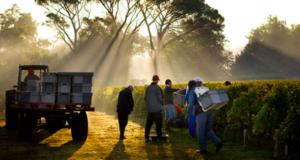 Bouscaut was then acquired in 1979 by Lucien Lurton, a well known Bordeaux winemaker who already owned at least ten other prestigious châteaux in appellations such as Margaux (Brane-Cantenac) or Barsac (Climens),…. This passionate viticulturist recognized the potential and exceptional terroir of Château Bouscaut.
Bouscaut was then acquired in 1979 by Lucien Lurton, a well known Bordeaux winemaker who already owned at least ten other prestigious châteaux in appellations such as Margaux (Brane-Cantenac) or Barsac (Climens),…. This passionate viticulturist recognized the potential and exceptional terroir of Château Bouscaut.
Sophie Lurton, Lucien’s daughter has been looking after Bouscaut since 1992. Laurent Cogombles, her husband, an agronomist, has also been very involved since 1997. Laurent is also the current President of the Appellation Pessac-Léognan.
Today, Château Bouscaut continues its journey, led with enthusiasm and innovation by its owners and team.
Château Bouscaut has recently joined a program of environmentally friendly practices.
Wine tourism is permanently evolving with various workshops available to do and the house at Château Valoux has been available for rental since 2011.
The Vines
The majority of the vines are red, covering 47 hectares, consisting of 55% Merlot, 40% Cabernet Sauvignon, and 5% Malbec. The remaining 7 hectares are divided equally between Semillon and Sauvignon Blanc. Overall, there is a vine density of 7,200 vines/ha. The average age of the vines is 40 years -although there are some that are over a hundred years old.
Vinification
The harvest is manually picked and put into small baskets, followed by temperature controlled fermentation (24-28ºC) in stainless steel and cement vats for the reds, and a cooler ferment (18-22ºC) in oak barrels (50% new) for the whites. The reds will see up to 18 months in oak, the whites up to a year with regular bâtonnage.

Château Bouscaut Pessac-Léognan
Appellation: Pessac-Léognan
Owners: Sophie Lurton & Laurent Cogombles
Average Age of the Vines: 35 years old
Soil: Clayey-calcareous and gravel
Grape Varieties: Merlot 48%; Cabernet Sauvignon 42%; Malbec 10%
Average Production: 40 hl/ha
Alcohol Content: 14.5%
Vinification: Fermented in stainless steel and concrete tanks, aged in oak barrels (45% new oak)
Food Pairings: Enjoyable with game birds, various meats, and soft cheese such as a good Camembert.

Les Chênes de Bouscaut Rouge
Appellation: Pessac-Léognan-Grand vin de Graves (Bordeaux)
Town: Cadaujac
Owners: Sophie Lurton & Laurent Cogombles
Soil: Clay on limestone bedrock
Average Age of Vines: 35 years
Average Production: 40 hl /ha
Grape Varieties: 72% Merlot; 28% Cabernet Sauvignon
Vinification: Stainless steel tanks and concrete with temperature control by water circulation
Food Pairings: Seafood such as sole, bar, saint-pierre, cabillaud, salmon, trout, etc. White meat such as poultry, veal, sweetbreads. Roasted or braised red meat. Cheeses with character, refined with strong aromas. Hard cheeses like cantal, tomme, and comté.



